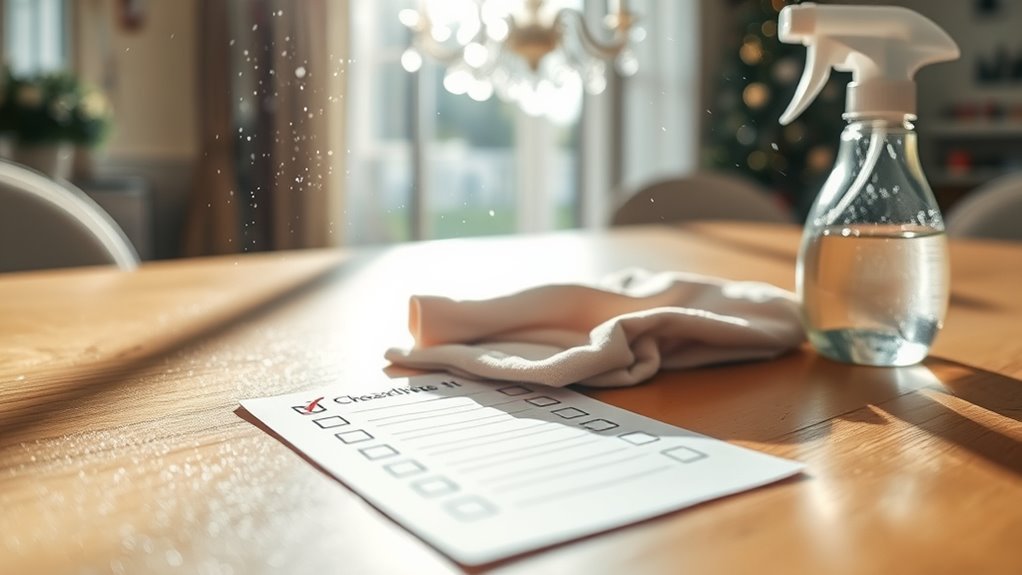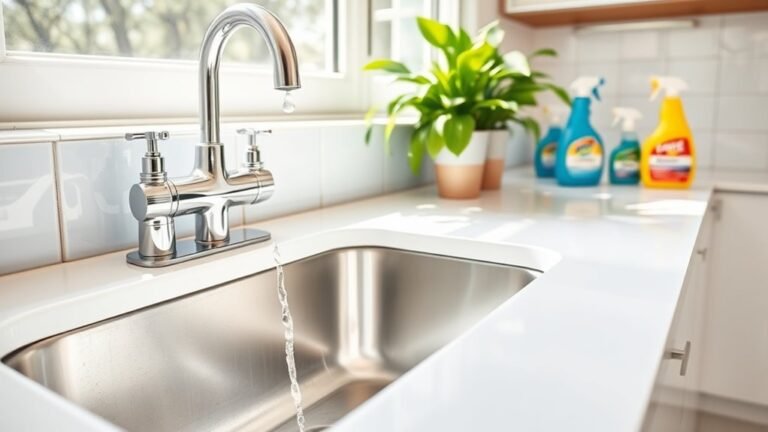Pre-Holiday Cleaning Checklist for Dust
To prep your home for the holidays, start by dusting high surfaces like ceiling fans and light fixtures with a microfiber duster, then work down to shelves, baseboards, and corners using a damp cloth. Thoroughly vacuum upholstery with attachments, clean electronics gently, and refresh window treatments by dusting or vacuuming carefully. Don’t forget to vacuum floors and carpets methodically, focusing on edges and high-traffic zones. Organizing and dusting storage areas completes the deep clean, setting a fresh stage for your celebrations. There’s more to uncover for a truly spotless home.
Dusting High and Low Surfaces

Dust is one of the most common allergens and can accumulate quickly on both high and low surfaces, so you’ll want to tackle these areas systematically. Start by dusting ceiling fans and light fixtures, as they often collect invisible layers of dust that can fall later. Use a microfiber duster with an extendable handle to reach these spots precisely without spreading dust into the air. Next, move downward to shelves, baseboards, and corners, wiping with a damp cloth to capture dust instead of dispersing it. Focus on areas where allergens hide unnoticed, like window sills and vents. By following this precise, step-by-step approach, you’ll clear dust effectively and maintain a cleaner, freer living space, making your home ready for the holidays and allergy relief.
Cleaning Upholstery and Fabrics
Two key steps guarantee your upholstery and fabrics stay fresh and allergen-free before the holidays. First, thorough vacuuming is essential—use a brush attachment to remove dust and debris from crevices and seams. This precise upholstery maintenance prevents buildup that triggers allergies. Second, apply a fabric protection spray designed for your material type; this barrier repels dirt and spills, making future cleaning easier. Test the spray on a hidden spot to avoid damage. Focus on frequently used pieces like sofas, cushions, and curtains. By following these methodical steps, you maintain fabric integrity and extend the life of your furnishings. Taking control of upholstery maintenance now frees you to enjoy a clean, welcoming home without last-minute stress or hidden allergens during holiday gatherings.
Tackling Electronics and Gadgets

When cleaning your electronics and gadgets, start by unplugging each device to prevent any damage or shocks. Use a microfiber cloth and gentle, alcohol-free cleaner to carefully wipe screens without leaving streaks or scratches. For dust removal, rely on soft brushes or compressed air to reach crevices without forcing particles deeper into the device.
Safe Dust Removal
Although electronics and gadgets may seem delicate, you can safely remove dust by following specific steps that prevent damage. First, power down and unplug devices to avoid electrical risks. Use a soft, microfiber cloth dampened with eco friendly products designed for electronics—avoid harsh chemicals that can harm surfaces or leave residues. For tight spaces, a soft-bristle brush or compressed air helps dislodge dust without scratching. Work methodically, starting from the top and moving downward to catch falling particles. This careful approach not only protects your gadgets but also supports allergy prevention by minimizing airborne dust. Maintaining clean devices guarantees they function efficiently while contributing to a healthier home environment, giving you the freedom to enjoy your technology without worry.
Cleaning Tips for Screens
Since screens are among the most frequently touched surfaces on your devices, cleaning them correctly is essential to maintain clarity and prevent damage. When it comes to screen cleaning and dust removal, follow these precise steps for ideal results:
- Power off your device to avoid damage or unintended inputs.
- Use a microfiber cloth—never abrasive materials—to gently wipe away dust and fingerprints.
- For stubborn spots, lightly dampen the cloth with distilled water or a screen-safe cleaner; avoid spraying liquids directly on the screen.
- Clean in straight, gentle motions to prevent streaks and preserve screen coatings.
Refreshing Window Treatments and Blinds
You’ll want to start by carefully dusting each slat of your blinds using a microfiber cloth or a specialized duster to avoid scratching. For fabric window treatments, check the care label before spot-cleaning or vacuuming with a brush attachment to remove dust and debris. Taking these precise steps guarantees your window coverings look fresh and welcoming for the holidays.
Dusting Techniques for Blinds
Anyone looking to refresh their window treatments will find that mastering dusting techniques for blinds is essential. Proper blinds maintenance not only enhances appearance but also supports effective dust prevention. To keep your blinds spotless and extend their life, follow these steps:
- Close the blinds fully and use a microfiber cloth or a duster specifically designed for blinds to gently remove dust.
- Flip the blinds to the opposite side and repeat the dusting process to cover all surfaces.
- For stubborn dust, lightly dampen the cloth with water or a mild cleaner, avoiding excess moisture that can damage the blinds.
- Regularly vacuum blinds using a brush attachment to remove dust from hard-to-reach areas.
Cleaning Fabric Window Treatments
Cleaning fabric window treatments requires a careful approach to preserve their texture and color while removing dust and stains. Start by gently vacuuming with a brush attachment to lift surface dust without damaging the fabric. For deeper cleaning, check the manufacturer’s fabric care instructions—some materials tolerate spot cleaning with mild detergent, while others need professional treatment. Avoid saturating the fabric to prevent watermarks or shrinkage. Regular window maintenance includes rolling or drawing treatments fully open to air them out and reduce dust buildup. By methodically maintaining your fabric window treatments, you’ll extend their lifespan and keep your space feeling fresh and open. This precise attention to fabric care not only refreshes your décor but also supports a cleaner indoor environment, offering you the freedom to enjoy your home fully.
Clearing Dust From Floors and Carpets

Although it might seem straightforward, clearing dust from floors and carpets requires a systematic approach to guarantee all particles are effectively removed. To maximize your cleaning freedom, follow these steps:
Clearing dust thoroughly demands a methodical approach to ensure every particle is removed for a cleaner home.
- Start with a thorough vacuuming using proper vacuuming techniques—slow, overlapping strokes assure deep debris extraction.
- Focus on high-traffic areas where dust accumulates faster; repeat vacuuming there for ideal carpet maintenance.
- Use attachments to reach edges and corners that standard vacuum heads often miss.
- Schedule regular carpet maintenance, including periodic deep cleaning, to keep dust from embedding and compromising air quality.
Organizing and Dusting Storage Areas
Three key steps will help you efficiently organize and dust your storage areas to prevent clutter and dust buildup. First, start by decluttering shelves—remove items you no longer need or use, creating space and reducing dust traps. Next, use organizing bins to categorize and contain remaining belongings; choose clear bins for easy identification and airtight lids to minimize dust penetration. Finally, dust every surface meticulously, including shelves, bin exteriors, and corners, using a microfiber cloth to capture particles effectively. Maintain airflow by keeping storage areas ventilated, which discourages dust accumulation. By following this precise approach, you’ll create a cleaner, more organized space that saves time in future cleanings and grants you the freedom to enjoy a clutter-free environment during the holidays and beyond.
Häufig gestellte Fragen
How Often Should I Deep Clean My Home for Dust Prevention?
Oh sure, you can let dust build a tiny empire before deep cleaning, but if you cherish freedom from sneezing fits, aim for a deep cleaning frequency of every three months. That’s your sweet spot for effective dust prevention strategies. Be methodical: target hidden corners, vents, and upholstery. Precision matters—don’t just skim surfaces. Staying consistent lets you reclaim your space without becoming a slave to endless chores.
What Are the Best Natural Dust Repellents for Home Use?
If you want natural dust repellents, try essential oils like eucalyptus, lavender, or tea tree. You can make homemade sprays by mixing a few drops with water and a bit of white vinegar in a spray bottle. Spray on surfaces and fabrics to help reduce dust buildup. These oils not only repel dust but also leave a fresh scent, giving you freedom from harsh chemicals while keeping your home cleaner and healthier.
Can Air Purifiers Reduce Dust Buildup Effectively?
You might think air purifiers could magically banish every speck of dust, but they’re not miracle workers. They do improve air quality by capturing airborne particles, which helps reduce dust buildup over time. However, their effectiveness depends heavily on regular filter maintenance—neglect that, and dust wins. To truly reclaim your freedom from dust, you need a precise routine: choose the right purifier, maintain its filter diligently, and combine with other cleaning habits.
How Do I Prevent Dust Accumulation on Frequently Used Items?
To prevent dust accumulation on frequently used items, you need to maintain dust free surfaces consistently. Wipe them down with a microfiber cloth daily cleaning to capture dust before it settles. Avoid clutter, which traps dust and makes cleaning harder. Use gentle, dust-attracting sprays if needed, but don’t overdo it. By being methodical and precise in your daily routine, you’ll enjoy cleaner, fresher spaces that let you focus on what matters most.
Are There Specific Cleaning Tools That Reduce Dust Spread?
Did you know that using the right dusting techniques can reduce airborne dust by up to 80%? When you want to minimize dust spread, microfiber cloths are your best friend. Their fine fibers trap dust instead of just moving it around, unlike traditional dusters. To maintain freedom from constant cleaning, wipe surfaces gently in one direction, and avoid shaking cloths outdoors, which releases dust back into the air. This method keeps your space cleaner longer.






